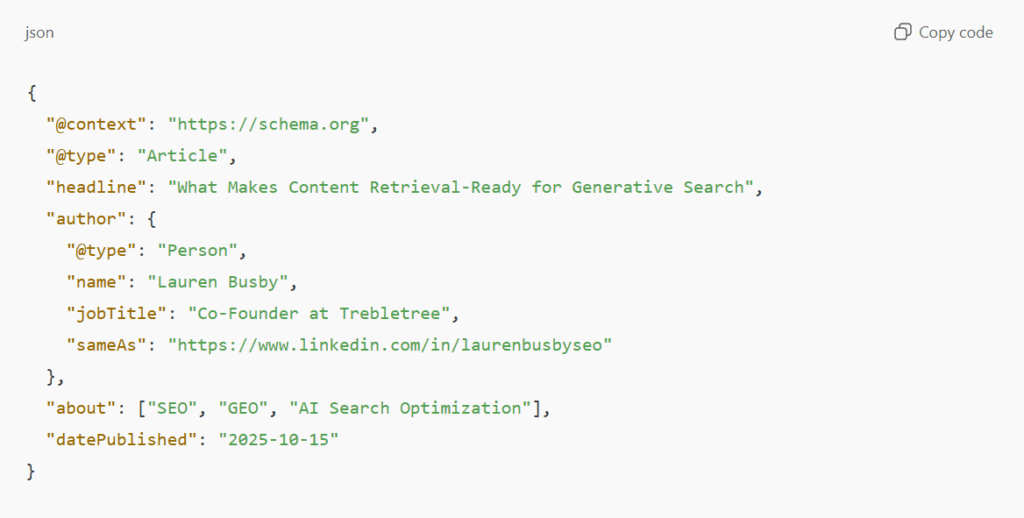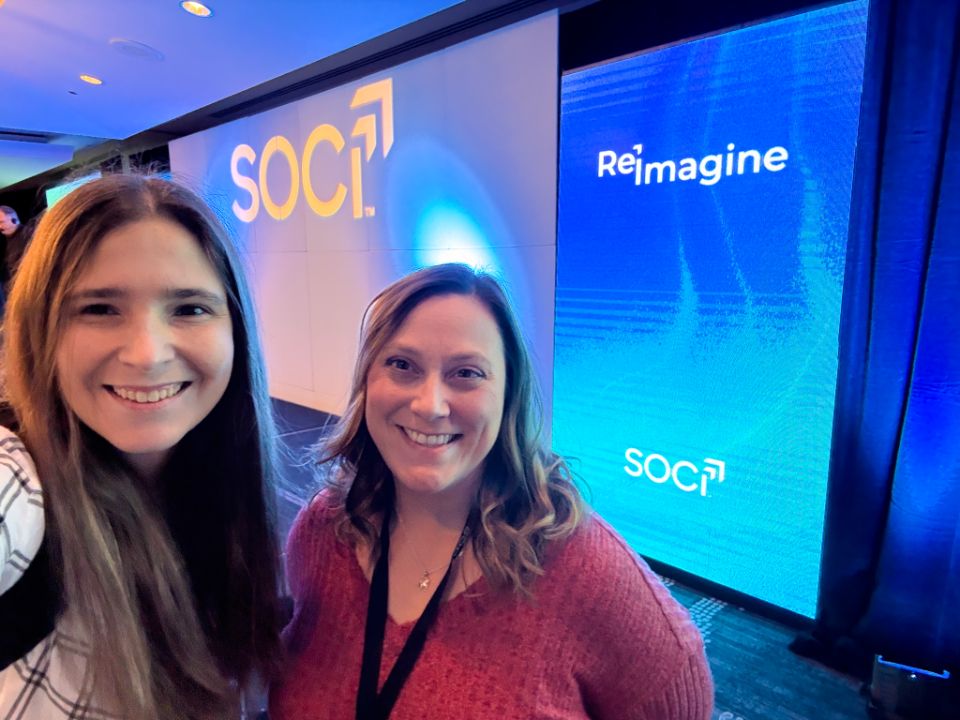After studying how AI systems decide which content to cite and reference, one thing is clear: the fundamentals of SEO still matter – but the mechanics of visibility have evolved entirely.
Most marketers are still optimizing for rankings when they should be optimizing for both rankings and retrievability. They’re celebrating page-one visibility while their content stays invisible to the AI systems now mediating discovery. This is where Generative Engine Optimization (GEO) comes in – the practice of making your content discoverable and citable by AI systems. You need both traditional SEO and GEO to win.
Understanding Embeddings: How AI Actually Processes Your Content
Traditional SEO is about indexing and ranking. Google crawls your page, indexes it, and decides where it should appear based on relevance signals and authority.
AI search optimization works fundamentally differently. AI systems use vector embeddings – mathematical representations that capture meaning and relationships rather than just matching keywords.
Think of it this way: when you write “digital marketing agency in Boston,” Google indexes those exact words. But an AI system converts that phrase into a numerical vector that represents the concept – linking it semantically to “marketing services,” “Massachusetts,” “B2B agencies,” and hundreds of related ideas.
How Embeddings Work
When an AI system reads your content, it creates an embedding – a multi-dimensional map of concepts and their relationships. If you write “digital marketing,” the AI doesn’t just note those two words. It maps connections to related concepts: advertising, SEO, content strategy, lead generation, B2B services, and hundreds of other semantically related ideas.
The process relies on identifying entities – any distinct, well-defined concept like a person, company, product, service, or idea. AI systems build embeddings by:
- Identifying entities in your content (What are you talking about?)
- Understanding attributes of those entities (What characteristics do they have?)
- Mapping relationships between entities (How do these concepts connect?)
Example of weak entity definition: “Our platform helps companies improve their online presence.”
AI sees generic entities: “platform” (what kind?), “companies” (which ones?), “online presence” (how?). The embedding is sparse and unlikely to be retrieved for specific queries.
Example of strong entity definition: “Trebletree’s SEO platform helps B2B SaaS companies optimize content for both traditional search rankings and AI-generated answers.”
AI now sees specific entities with clear attributes and explicit relationships: Trebletree creates a platform FOR B2B SaaS companies TO optimize content RESULTING IN both traditional rankings AND AI visibility. This creates a rich, multi-dimensional embedding that gets retrieved when someone asks about SEO tools for SaaS companies or optimizing for AI search.
The Retrieval Process
When someone prompts an AI, it doesn’t search through billions of pages. It searches through these embeddings for the most contextually relevant information. That process is retrieval – and it’s why some content gets cited while others disappear.
Here’s an example: A client ranks top three for their core keyword. Strong domain authority, excellent backlinks, great traditional metrics. Yet when we analyze their AI visibility, they appear zero times in generated answers. Their content was keyword-optimized but semantically thin – AI couldn’t extract clear entity relationships or contextual depth. The content was indexed, but it wasn’t embedded properly.
In this example, we don’t abandon their SEO work – we strengthen it. We layer in semantic structure and entity clarity that make their already-strong content comprehensible to AI systems at the embedding stage. Their rankings stay strong and AI-generated answers began citing their content.
Why Retrieval Matters Now
Here’s what I’ve seen firsthand with clients navigating this shift: your content might rank #1 on Google but never appear when someone asks ChatGPT, Perplexity, or SearchGPT a question about your industry.
Why does this matter? Because when AI systems answer questions about your space without mentioning you, your competitors get cited instead. I’ve watched companies lose mindshare in real-time – not because their rankings dropped, but because AI systems consistently referenced competitors when prospects asked for recommendations, comparisons, or solutions.
You’re not just missing traffic. You’re missing the moment when someone forms an opinion about who the authorities are in your space. AI-generated answers don’t include ten blue links for users to evaluate – they include two or three sources, presented as definitive. If you’re not one of them, you don’t exist in that buyer’s consideration set.
Traditional search visibility and AI visibility aren’t the same thing – and the gap between them is costing companies qualified opportunities they don’t even know they’re losing.
The question isn’t just “Can Google find me?” It’s also “Will AI remember me when generating answers?”
As generative search reshapes discovery, visibility now exists in two places: search results and AI-generated responses. Your content must perform in both worlds.
Retrieval-ready content requires three elements:
- Structural clarity – Clean hierarchy and markup that AI can parse accurately
- Semantic richness – Well-defined entities and contextual relationships that create meaningful embeddings
- Trust signals – Attribution, recency, and consistency that build retrieval confidence
If you’re already doing strong SEO, you’re 70% there – thanks to the focus on E-E-A-T. Generative engine optimization refines and extends what already works.
1. EEAT: The Foundation That Makes Everything Retrievable
Here’s the good news: if you’ve been doing solid SEO for the past few years, you’ve already been building the foundation for generative engine optimization.
Google’s EEAT framework (Experience, Expertise, Authoritativeness, Trustworthiness) isn’t just a ranking factor – it’s the bedrock of AI retrieval. Every signal that tells Google you’re trustworthy also tells AI systems you’re citation-worthy. We’ve been optimizing for EEAT for over two years now, and that work directly translates to GEO success.
Here’s why EEAT underpins all three elements of retrieval-readiness:
- EEAT creates trust signals that AI systems evaluate before citing content. When generating an answer, AI systems weight sources based on authoritativeness signals embedded in and around your content. Author credentials, publication dates, citations, and cross-platform consistency all factor into whether AI considers your content reliable enough to reference.
- EEAT strengthens semantic richness by establishing clear expertise domains. When you demonstrate deep knowledge in specific areas through consistent terminology, comprehensive coverage, and authoritative positioning, you’re creating the entity clarity that AI systems need to understand what you’re an expert in and when to retrieve your content.
- EEAT supports structural clarity by encouraging organized, well-sourced content. Authoritative content naturally includes proper attribution, clear organization, and transparent authorship – all structural elements that help AI systems parse and embed your content accurately.
How to strengthen EEAT for both SEO and GEO:
- Author attribution with real credentials. Not just names – include relevant experience, specific expertise areas, and professional background. “Written by Sarah Johnson, Director of Content Strategy with 12 years in B2B SaaS marketing” gives both Google and AI systems confidence in the source.
- Clear publication and update timestamps. Temporal context matters for both ranking and retrieval. “Published March 2025, last updated October 2025” signals that information is current and actively maintained.
- Outbound citations to authoritative sources. When you make claims or cite statistics, link to reputable sources. This creates validation pathways that both Google and AI systems can verify, increasing confidence in your content.
- Consistent entity data across the web. Your LinkedIn profile, company website, author bios, and knowledge graph entries should all tell the same story about who you are and what you do. Inconsistencies create doubt; consistency builds trust.
- Demonstrate real experience. Share specific examples, case studies, and firsthand insights that prove you’ve done the work, not just read about it. AI systems increasingly weight experiential knowledge.
Here’s the key insight: retrieval systems don’t just ask “Is this relevant?” They ask “Is this relevant and trustworthy enough to cite?” Your EEAT signals directly influence that confidence threshold.
The best part? If you’ve been building EEAT properly for traditional SEO, you’re already creating the trust foundation that makes AI retrieval possible. You don’t need to start over – you need to ensure those signals are consistently expressed across all the technical and semantic elements we’ll cover next.
2. Structural Clarity: Making Content Machine-Parseable
AI systems can’t embed what they can’t parse. Structural clarity isn’t cosmetic – it’s foundational to how AI understands your content.
When AI crawlers encounter your content, they’re looking for clear hierarchies and relationships. Clean HTML structure, semantic markup, and logical organization all influence how accurately your content gets embedded – and therefore how retrievable it becomes.
- Use semantic HTML intentionally. Heading hierarchies (H1, H2, H3) aren’t just for visual organization – they signal conceptual relationships to AI systems. An H2 under an H1 tells machines “this subtopic belongs to that main topic.”
- Maintain a clean, accessible DOM. Overly complex JavaScript rendering or inaccessible design patterns can interfere with how AI systems parse your content. If your site relies heavily on client-side rendering without proper server-side alternatives, AI crawlers might struggle to extract coherent information for embedding.
- Prioritize information architecture. The way you organize topics, structure navigation, and connect related content all influence how AI systems map your expertise domain.

Good structure creates clean, accurate embeddings. Poor structure creates noisy, ambiguous ones – or none at all. And if your content isn’t embedded properly, it won’t be retrieved.
3. Schema Markup: Explicit Context for Machine Understanding
Yes, schema is a huge component of making your content machine-paresable. But, it’s so important that it deserves its own section.
Schema markup (structured data) provides explicit context that reduces ambiguity during the embedding process. When you mark up an article with author information, publication date, and topical relationships, you’re not just helping with rich snippets – you’re helping AI systems create more accurate, contextually rich embeddings.
Think of the difference between AI reading “Lauren Busby wrote this” versus “Lauren Busby (credentials: 15 years in SEO, role: Co-Founder at Trebletree) authored this article about generative search optimization, published October 2025, related to topics: SEO, AI, content strategy.”

The second version creates a far richer embedding that captures expertise, recency, and topical relationships.
The schema that matters most for AI search optimization:
- Organization and Person schema – Establish entity relationships and authority signals
- Article schema – Provide content-type clarity and temporal context
- FAQ and HowTo schema – Help AI understand intent and information structure
- sameAs and mentions properties – Connect your entities to verified external knowledge bases
Schema isn’t optional anymore – it’s foundational to creating embeddings that AI systems can confidently retrieve and cite. Your development team should be implementing this systematically across your content.
4. Creating Semantically Rich Content: From Thin to Retrievable
This is where many sites fail at GEO despite having strong SEO. They understand structure and schema, but their actual content lacks the semantic depth that creates strong embeddings.
What Makes Content Semantically Thin
Semantically thin content creates weak embeddings because:
- Heavy keyword repetition without context gives AI no relationship data to embed
- Isolated facts don’t show how concepts connect, creating sparse embeddings
- Missing “why” and “how” leaves out the reasoning that creates dimensional depth
- Undefined or vague entities create ambiguity that weakens embedding accuracy
- Lack of related concepts means your embedding exists in isolation
How to Build Semantic Richness
1. Define entities explicitly every time you mention them.
Why this matters: Vague references create weak embeddings. “Our platform” tells AI nothing about what kind of platform, what it does, or who it serves.
How to do it: “Trebletree’s SEO platform helps B2B SaaS companies optimize content for both traditional search rankings and AI-generated answers.”
This gives AI multiple clear entities with explicit attributes and relationships. The embedding becomes rich and multi-dimensional, making it retrievable when someone asks about SEO tools for SaaS companies or optimizing for AI search.
2. Maintain terminological consistency across all content.
Why this matters: When you use different terms for the same concept, you fragment your entity identity. If you call something “content strategy” on one page and “content planning” on another, AI creates multiple weak embeddings instead of one strong one.
How to do it: Choose your core terminology and use it consistently. If you specialize in “generative engine optimization,” use that exact phrase throughout your site. Don’t alternate between “GEO,” “AI search optimization,” and “generative search optimization” unless you explicitly define their relationships.
3. Build explicit conceptual connections.
Why this matters: Embeddings capture relationships between entities, not just individual concepts. The connections you draw create dimensional depth.
How to do it: Instead of “SEO is important. GEO is important,” write “SEO and GEO work together because both optimize for discovery – SEO for traditional search engines, GEO for AI retrieval systems.
This creates relationship mappings: SEO ↔ GEO (related), both → discovery (shared purpose), different mechanisms (distinction). AI can now retrieve your content when someone asks about the relationship between traditional and AI search.
Include related concepts naturally. If discussing “content optimization,” also mention “semantic structure,” “entity clarity,” “topical authority.” These related terms create denser, more connected embeddings.
4. Answer “why” and “how,” not just “what.”
Why this matters: Explanatory content creates causal relationships in embeddings. When you explain reasoning, you add dimensional depth that makes embeddings more retrievable.
How to do it: Instead of “Use schema markup,” write “Schema markup provides explicit context that helps AI systems create accurate embeddings by removing ambiguity about what your content means and how entities relate.”
This creates multiple relationship layers that produce rich embeddings far more retrievable than simple statements.
5. Use descriptive, entity-rich internal links.
Why this matters: Links help AI understand how entities in your ecosystem relate. Descriptive anchor text creates explicit relationship mappings.
How to do it: Instead of “click here,” use “explore our approach to technical SEO for generative search.”
This tells AI which entities connect and how, helping it understand your knowledge graph and making you more retrievable for related queries.
6. Define specialized terms on first use.
Why this matters: Undefined jargon creates gaps in embeddings. When AI encounters “GEO” without definition, it has to guess – and that uncertainty weakens retrieval confidence.
How to do it: First mention: “Generative Engine Optimization (GEO) is the practice of…” Subsequent mentions can use “GEO” because you’ve established the entity relationship.
7. Include concrete examples.
Why this matters: Abstract concepts create thin embeddings. Concrete examples add specificity and context that create richer representations.
How to do it: “Entity-based SEO focuses on clearly defining what you are. For example, instead of targeting ‘digital agency,’ define your entity as ‘Trebletree is an organic digital agency specializing in SEO and GEO for B2B SaaS companies.'”
The example adds concrete entities that create much richer embeddings than abstract concepts alone.
The Semantic Richness Test
Can someone unfamiliar with your industry understand:
- What specific entities you’re discussing
- How those entities relate to each other
- Why those relationships matter
- What makes your expertise distinct
If yes, you’ve created semantic richness that produces strong embeddings. If not, your content is too thin – and your embeddings will be weak, even with perfect technical SEO.
5. Topical Authority Through Content Clustering
Building topical authority isn’t about having the most content – it’s about having the most interconnected, comprehensive content around specific domains of expertise.
When you organize content into strategic clusters around pillar topics, you’re demonstrating depth and breadth simultaneously. This matters for both traditional SEO and AI retrieval because it signals: “This site has comprehensive, interconnected knowledge about X topic.”
AI systems don’t just evaluate individual pages in isolation. They map your entire content ecosystem to understand your expertise boundaries. A well-clustered site creates dense, interconnected embeddings around specific knowledge domains – making you the authoritative source AI systems retrieve when they need information in those areas.
Build retrieval-ready topical architecture:
- Create pillar content that comprehensively covers core topics in your domain. These are your definitive guides – the pages that establish you as an authority on foundational concepts.
- Build supporting content that explores specific aspects, use cases, subtopics, or applications in depth. Each supporting piece should connect back to your pillar content and to related supporting pieces, creating a web of expertise.
- Organize by topic, not just keywords. Group content around concepts and themes, not just search terms. Content strategy for B2B SaaS” becomes a cluster with pieces on content audits, editorial calendars, distribution strategies, and measurement – all interconnected.
- Use internal linking strategically to reinforce these relationships. Link with entity-rich, descriptive anchor text like “explore our approach to technical SEO for generative search” rather than generic phrases. These links help AI systems understand how concepts within your expertise domain connect.
- Structure navigation to reflect your topical organization clearly. Your site architecture should make it obvious where you have deep knowledge and how different areas of expertise relate.
This approach serves dual purposes: it builds traditional topical authority that helps with ranking, and it creates a clear knowledge graph that AI systems can parse and understand. When AI needs authoritative information in your domain, a well-clustered site makes it obvious you’re the expert to cite.
Think of content clustering as building your expertise map – not just for users, but for the AI systems deciding who to reference when answering questions in your space.rconnected embeddings around specific knowledge domains – making you more retrievable when AI systems need authoritative information in those areas.
6. Content Freshness and Embedding Recency
AI systems value freshness differently than traditional search engines. Updated content isn’t just re-crawled – it’s re-embedded with current context.
When you update content, AI systems may re-embed it, refreshing its position in their retrieval systems. Stale, outdated content creates embeddings that lose retrieval strength over time – particularly for topics where currency matters.
Maintain embedding relevance:
- Update cornerstone content quarterly to maintain strong, current embeddings
- Add clear timestamps and changelogs that signal active maintenance and reliability
- Refresh statistics, examples, and references to keep contextual alignment strong
- Monitor which content appears in AI citations and prioritize those pages for updates
Think of content maintenance as embedding reinforcement. Regular, meaningful updates keep your content in AI systems’ active retrieval set rather than letting it fade into lower-confidence territory.
The New Standard: SEO + GEO
The future of visibility isn’t SEO versus GEO. It’s SEO through GEO.
Good SEO and good generative engine optimization aren’t separate disciplines – they’re increasingly the same practice executed with greater semantic precision. Every optimization that improves crawling and ranking also strengthens embeddings and retrieval.
When you structure content for clarity, you improve both traditional indexing and AI embedding. When you define entities explicitly, you strengthen both ranking signals and retrieval confidence. When you build trust through attribution and citations, you enhance both domain authority and AI confidence thresholds.
The difference lies in execution standards. GEO demands:
- Greater semantic precision in how you define and relate concepts
- Stricter structural consistency in markup and organization
- Deeper entity clarity in terminology and relationships
- Stronger trust signals woven throughout content and attribution
The companies succeeding aren’t choosing between SEO and GEO. They’re recognizing that visibility now spans both traditional search results and AI-generated answers – and they’re optimizing with both mechanisms in mind.
Because in this new era of discovery, the best content isn’t just found – it’s remembered.




